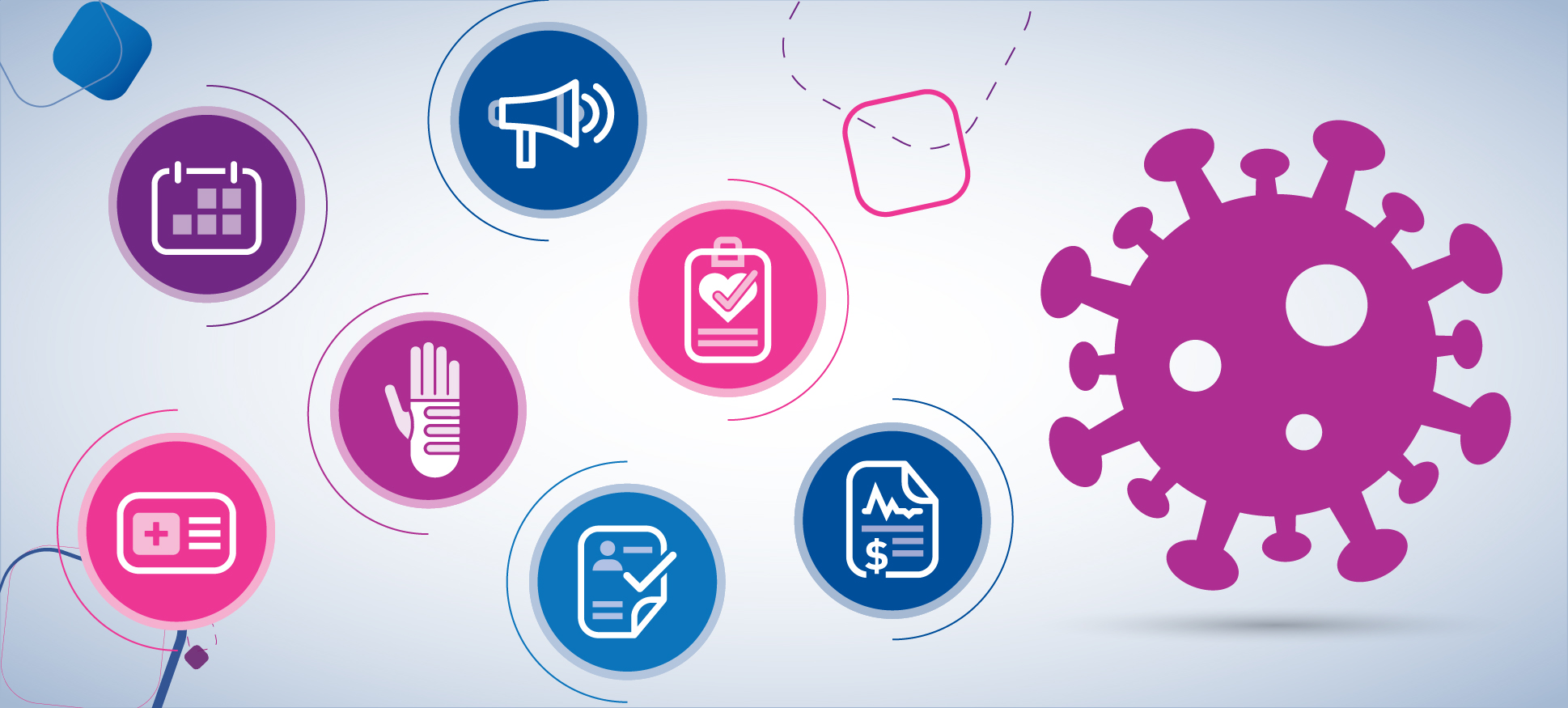Collections Optimization
Boost revenue, streamline patient financial assistance, and reduce collection costs.

Being able to settle bills anytime, anywhere, is one of the reasons why 110 million Americans switched to “digital-first” payment methods last year. Today’s consumers can pay household bills with their mobile devices while cooking dinner or waiting in the school pick-up line. They can pay for their morning coffee by tapping their phone at the point of sale. Imagine their frustration when paying for healthcare still involves paper bills, multiple phone calls, and limited payment options. But the healthcare industry can make the same “anytime, anywhere” payment promise. Berenice Navarrete, Director of Product Management for Patient Payments at Experian Health, says: “We’ve seen healthcare make great strides in using automation and digital tools for scheduling, registration, and telehealth, fueled in no small part by the pandemic. As consumer payments are constantly evolving, there are huge opportunities for improvements in the patient payment experience too.” “We’ve seen healthcare make great strides in using automation and digital tools for scheduling, registration, and telehealth, fueled in no small part by the pandemic. As consumer payments are constantly evolving, there are huge opportunities for improvements in the patient payment experience too.” -Berenice Navarrete, Director of Product Management for Patient Payments Experian Health’s recent Payments Predictions white paper identifies seven emerging healthcare payment predictions and trends heading into 2022. This blog offers a preview of the top three insights that will be of interest to providers intending to leverage – or considering – digital tools that simplify payments and speed up healthcare collections. Prediction: Patients want fast, secure and smooth payments to match their experience in other industries. According to Experian Health’s State of Patient Access 2.0 survey, providers are feeling more confident about collecting payments from patients now, compared to a year ago. However, the collections landscape is always changing; providers should continue to find ways to match consumer expectations with tailored communications, flexible payment options and automated payment methods. Listen in as Matt Baltzer, Senior Director of Product Management at Experian Health, explains why providers feel more confident about patient collections. He also discusses how automated healthcare solutions can help providers shore up these gains and optimize healthcare collections – especially as consumer behavior returns to pre-pandemic patterns. As cash usage declines, patients are looking for a wider variety of payment options – a trend that’s likely to gather steam as digital payment platforms like Apple Pay and Google Pay continue to gain traction. Providers must keep pace with these advances in consumer payment technology. Utilizing Patient Financial Advisor is one way to give patients the flexible experience they want. This solution sends personalized text messages with links to convenient and contactless ways to pay. Patients may have different preferences about payment methods, but they all want to feel confident that their payment is secure. With PaymentSafe, healthcare providers can collect any form of payment securely and quickly, regardless of the payment option a patient chooses. Prediction: Patient loyalty will be tied to a convenient and compassionate payment experience. A poor payment experience will leave a bad taste in the patient’s mouth, regardless of how good the rest of their healthcare journey has been. With 70% of consumers saying healthcare is the industry that makes it hardest to pay, any provider that offers a smooth, supportive and transparent payment experience is going to stand out from the competition and foster greater patient loyalty. Comprehensive consumer data can give providers early and accurate insights into a patient’s specific financial situation. This information can help providers direct the patient to the most appropriate financing options. Automation can then be leveraged to send timely reminders of open balances, improve patient engagement and minimize the risk of missed payments. Tools such as Patient Financial Advisor and Patient Payment Estimates can help providers give patients transparency, control and reassurance from the very start of their financial journey, so bills are settled quickly and easily. Prediction: Automation will be used for an increasing number of payment-related tasks. Artificial intelligence and automation aren’t just for cars and the metaverse. Technological advancements are opening up a wide range of benefits to healthcare providers, from faster patient payments to fraud prevention. Automation also enables operational efficiencies in reporting and reconciliation, while protecting and processing unprecedented amounts of patient data. For example, Collections Optimization Manager uses extensive datasets and advanced analytics to segment patient accounts according to each individual’s specific financial situation. Patient satisfaction will improve because patients receive the right support at the right time. Additionally, providers will be able to use monitoring and benchmarking data to spot previously unseen opportunities and further improve collections. Keeping that “anytime, anywhere” promise COVID-19 was a catalyst for the evolution of healthcare payments. Digital payment solutions that give patients easy, convenient, and safe ways to pay not only help meet changing consumer expectations but will also allow providers to boost loyalty and revenue for years to come. Download the white paper to discover a full list of healthcare payment predictions and find out how to create a modern payment experience that meets patient expectations.

A little over a year ago, Experian Health surveyed healthcare providers for a snapshot of their views on the digitalization of patient access, and the importance of healthcare collections. At the start of the COVID-19 pandemic, patient collections emerged as a top priority, the result of rising unemployment and competing consumer demands that impeded patients’ ability to pay. By June 2021, provider attitudes had changed. Our follow-up State of Patient Access 2.0 survey revealed that patient collections were no longer the number one concern for healthcare providers. Patient perceptions of the billing process have improved too. In our latest Interview with the Expert, Matt Baltzer, Senior Director of Product Management at Experian Health, explains why providers feel more confident about patient collections. He also discusses how automated healthcare solutions can help providers shore up these gains and optimize healthcare collections – especially as consumer behavior returns to pre-pandemic patterns. Watch the interview below: Why are healthcare collections no longer the number one concern for providers? In the six months between the two surveys, the number of providers saying they were “concerned or very concerned” about collecting payments from patients dropped from 50% to 41%. Baltzer explains that during this time, collection rates were relatively steady (when adjusted for volume), and providers received fewer calls about patient balances. Currently, the bigger concern for both providers and patients is to determine patients’ coverage status quickly and accurately. There are three main reasons for this shift. Firstly, multiple rounds of stimulus payments issued by the government helped consumers pay down their debts, including medical bills. Secondly, the pandemic caused a drop in consumer spending on travel, entertainment and dining out, which meant credit card usage was lower than pre-pandemic levels. Consumers had more cash available to pay healthcare bills. And thirdly, employment rates have started to recover. Around the time of the first survey, providers were faced with a surge in patients who had suddenly lost employer-based coverage, but as unemployment levels improve again, this is less of an issue. Those still affected by job losses have been able to access expanded government support, such as Medicaid. How should providers prepare as consumer spending returns to pre-pandemic levels? As Americans start to return to previous consumer habits and routines, household spending is likely to increase, which could squeeze medical bills again. Baltzer explains that “as we see stimulus programs winding down, and discretionary spending options increase, we can expect to see an increase in the utilization of revolving credit lines. For most consumers, that will mean it’s more difficult to meet unplanned out-of-pocket obligations.” Prior to the pandemic, a survey by the U.S. Federal Reserve found that 40% of Americans struggle to find $400 to pay for an unexpected bill. This means providers may not be able to rely on the steady collection rates seen in recent months. While efforts to improve transparency will help patients prepare for possible financial obligations, many providers are going further, implementing the right data, tools, and strategies to understand and address each consumer’s unique situation, making it as easy as possible for patients to pay. Baltzer says: “Data can help drive attention to the accounts with a higher likelihood to pay. This means you can identify those who just need a little more time to pay, and then help those truly in need of charity support. Things can change quickly, and having fresh, accurate data will be essential. Now is not the time to take our eyes off the ball, as the game may shift quickly.” With access to reliable and comprehensive consumer data and automated patient collections solutions, providers can tailor the patient experience according to individual needs and preferences. They can create a more empathetic financial experience, with upfront pricing estimates, personalized payment plans and flexible payment options. Not only will this be more desirable for patients, but it will also optimize healthcare collections, improve operational efficiency and increase the chances of more bills being settled in full. How can optimizing patient collections offset recent staffing challenges? Staffing shortages remain a growing challenge for healthcare providers. According to Baltzer, technology and automation can help ease the pressure on collections teams. He says, “Automation is key. Providers are being challenged to make the most of limited staff resources, especially for patient collections. It’s important to focus staff attention on the accounts most likely to pay. That means filtering out accounts that might be bankrupt or deceased and using automation for manual tasks – such as checking for charity eligibility or cleaning up patient records. Best-in-class providers are increasingly leveraging automated dialing and texting solutions to communicate with patients and help short-staffed teams focus on the tasks that matter.” Collections Optimization Manager can help organizations deploy a targeted approach to patient collections, using data and analytics to segment, screen and monitor accounts. By optimizing on the back end with user-friendly interfaces and efficient workflows, staff can focus their efforts on the accounts that need the most attention. On the front end, Patient Outreach solutions can help patients take control of their own financial journey with timely bill reminders and self-pay options, and requires minimal staff intervention. Automated text and IVR messages that connect directly to billing software ensure that more accounts are settled without adding to the organization’s headcount. Watch the full conversation, and download the State of Patient Access Survey 2.0, to find out more about how Experian Health can help your organization spot new opportunities to optimize healthcare collections.

COVID-19 transformed the patient journey, and it's clear when we evaluate every step. Data and technology gave patients the convenience, flexibility, and control to get care on their terms, and these changes will be here to stay. From marketing to scheduling to payments and more - providers and payers have ample opportunities to respond to these changes and will need to adapt their future strategies accordingly. Self-scheduling, mobile registrations, and automated authorizations are a few examples of tools and technologies that are more than likely to remain prominent in healthcare. What other changes are here to stay? In this new infographic, we take a dive into each of the 7 steps to see how data and technology has impacted the patient journey, and provide strategic recommendations on how providers and payers can adjust post-pandemic: The use of data and digital tools opened up new doors for greater patient access, engagement, transparency, and control. The post-COVID-19 patient journey is going to continue to evolve - payers and providers will need to adapt to keep up with the changes, to ensure that patients experience the best outcomes. To get a deep dive into all of the changes to the patient journey, download our white paper.

COVID-19 changed every aspect of the patient journey – placing unprecedented demands on the healthcare system and accelerating the need for digital transformation industry-wide. Telehealth, touchless engagement, and self-service scheduling became the new normal; however, this created new stress on operations, administration, and finance. While this new normal comes with many challenges, data and digital tools have created greater accessibility, engagement, transparency, and control for patients and providers. In this blog, we examine COVID-19’s impact on the patient journey and explore the digital tools and data that are helping the healthcare industry recover and thrive. To get more insights, read the full whitepaper here. COVID-19 strained the healthcare system more than ever before. To say that COVID-19 challenged the healthcare system is a massive understatement. Seven in 10 patients deferred or canceled treatments during the pandemic, causing disruptions to both revenue and patient engagement. Even behind the scenes, novel diagnostic codes and new sources of information—together with rising inpatient volume and government intervention—affected costs, billing and reimbursements at scale. Patient-provider relationships became much more complex. Many people moved, changed jobs and changed insurance during the pandemic. In fact, an estimated 40 million Americans lost work during the pandemic and just over half of all workers in North America plan to look for new work in 2021. As a result, relationships between physicians and patients became disrupted. While re-engagement is critical for providing care, simply finding patients remains a challenge. The digital experience raised patient expectations. As consumers turned to technology to cope with changes, digital engagement increased in healthcare services and elevated consumer expectations. This trend began before the pandemic: A pre-COVID-19 AARP survey of older adults (50+) found that a majority would prefer to have their healthcare needs managed by a mix of medical professionals and technology. During the pandemic, patients used telehealth to access care from home, mobile registrations to avoid filling out paperwork in the waiting room and digital payment options that made paying bills simple and seamless. Now that patients have experienced telemedicine, self-service scheduling and easy digital payments, there is no going back. Expectations have changed permanently, and providers that don’t offer an updated patient experience may suffer by comparison. Opportunities for better outcomes: transforming the patient journey with digital transformation We looked at key parts of the patient journey where technology is helping healthcare providers engage and care for their patients successfully across the marketing, scheduling, registration, authorization, treatment, claims and payment. Here are a few strategic opportunities for providers to consider post-COVID: 1. Use smart data for better outcomes Third-party data is helping providers find and re-engage patients, deliver more holistic care and facilitate better financial outcomes. For example, integrating data on social determinants of health (SDOH), can provide physicians with a more holistic picture of non-medical factors that may influence medical outcomes, such as a patient’s socioeconomic status. SDOH data can also shine a light on a patient’s ability to pay, which in turn may inspire a wider range of payment options so that more patients can afford care, and more providers can avoid write-offs. 2. Continue using technology and automation for the recovery to come Using digital self-service applications for registration does more than just provide the patient-friendly option of completing paperwork at home (instead of the waiting room). It also eliminates the need for staff hours spent inputting information, reduces the potential for error, and improves efficiency. Advances in automation make it possible for providers to reduce the effort of manual tasks - like sorting through patient records from disparate sources to create a single, comprehensive patient file, or gathering the information necessary to revisit claims authorization for deferred care. Across the board, digitalization provides greater transparency, flexibility, and seamless experiences for patients and providers alike. 3. Clear the path for payments Going digital can help patients and providers better navigate the patient journey, especially when it comes to payments. As many as half of nonretired adults expect long-term financial effects as a result of the pandemic. This makes it more imperative than ever to improve and accelerate authorization, claims, and payment processes so that both patients and providers have a clearer understanding of how care will be paid for. Accurate patient estimates, coverage discovery, automated authorizations, and payments all play a role in creating a better financial experience going forward. Digital transformation gains traction as we look to the future Although the digital transformation was already underway before COVID-19, the pandemic has accelerated the need for data, automation, and self-service tools. Find out how Experian Health can help your organization meet the data challenges of the post-COVID-19 patient journey by downloading our white paper.

"93% of providers say creating a better patient experience remains a top priority, up 3% from last year." - Experian Health's State of Patient Access, June 2021 In November 2020, we surveyed patients and providers for their sentiments on how patient access changed because of the pandemic. During this time, patients welcomed the convenience and control that came with digital, contactless care. Providers knew they needed to improve their digital front door to withstand the financial impact of COVID-19, but implementation was difficult for many organizations. Six months on, and millions of immunized Americans later, the pandemic landscape shifted again. In June 2021, we revisited these questions to find out if patient and provider views have changed - in our State of Patient Access 2.0. Now, patients tell us they feel more confident about returning to facilities, though they still want the flexibility and convenience of digital scheduling, registration, and payment options. Providers feel a growing urgency to make sure online services are sufficiently agile enough to withstand any future surges in COVID-19 case numbers. The findings of the survey reveal four major opportunities to rethink how we “do” healthcare. By innovating and building on the digital advances made possible during the pandemic, providers can create better patient access experiences for the future. To start, providers should: 1. Match consumer expectations for convenient and flexible patient access Our recent survey shows that the pandemic has cemented consumer expectations around convenient access to care. Digital and remote channels for scheduling appointments, completing pre-registration, and making payments have become the new baseline in patient access. Nearly three quarters of patients told us they want to schedule their own appointments online. Providers know this: 93% say creating a better patient experience remains a top priority, up 3% from last year. Online self-scheduling can help providers continue to meet their patients’ demands for flexibility and convenient access to care. Patients can find, book and cancel appointments whenever and wherever they prefer. It’s also a win for providers, who can expect to see a drop in administration errors, no-shows, and denied claims. 2. Streamline prior authorizations as more patients return to care Interestingly, new data reveals that patients are less anxious about in-person care. In 2020, 40% of patients were uncomfortable coming into waiting rooms and seeing their doctor in person. Now, only 16% say they wouldn’t be comfortable in a waiting room. As more patients rush to reschedule deferred care, providers are faced with the challenging combination of higher patient volumes, patients jumping health plans as a result of job losses, and changing payer rules around prior authorizations and coverage checks. Automated pre-authorization and automated coverage checks can relieve the pressure, and help providers save time and resources. 3. Promote price transparency for fewer missed payments An encouraging piece of insight from our latest survey reveals that far fewer patients say they’ve been surprised by their final medical bill. In 2020, more than 50% received a final figure that differed significantly from estimates. Six months later, that figure has dropped to just 14%. Price transparency remains important, and the gap between estimated and final costs seems to be closing. More providers are offering patient billing estimates, with 9 in 10 agreeing that accurate estimates increase the chance of bills being paid on time. Many are also giving patients more options to pay bills earlier in the journey, which has helped to minimize the risk of late and missed payments. Easy and accessible digital options are featured heavily in acquisition and retention plans, and can help drive financial recovery. 4. Tighten up data strategies with better security, quality and insights While our first survey revealed that the sudden shift to digital-first patient access was a shock to the system for many providers, the second study shows that both patients and providers are settling into digital ways of working. But as these digital services become the new baseline, providers must make sure their data strategies are fit for purpose, and prioritize data security, quality and insights. Moving forward, a multi-layered approach will help providers authenticate and secure patient identities. When these identities are enriched with information about how patients are affected by the social determinants of health, providers will be better positioned to offer personalized patient access experiences and support marginalized groups. The future of healthcare is digital. Is your organization prepared? It’s clear from our recent survey that the digital trends that emerged in 2020 are set to continue throughout 2021 and beyond. Download the State of Patient Access 2.0 white paper to get the full survey results and explore how data and digitalization can power a 24/7 patient access experience in your healthcare organization.

The pandemic dominated healthcare in 2020, but it won’t be recognized as a reason to delay complying with CMS’ price transparency mandate, which went into effect on Jan. 1, 2021. A recent study conducted by HealthAffairs indicated that 65 of the 100 largest hospitals in America had not complied as of February 2021. And new reports from CMS suggest $300 daily fines will follow if CMS warning letters have no impact, in addition to the possible public exposure of facilities failing to be compliant. There are a number of reasons why price transparency has generated so much attention – both before and during the COVID pandemic. Consumer advocates point to other transactional experiences, such as auto and home purchases, where understanding the price is complicated, but achieved. There’s been a lot of research on price transparency’s impact on patients, as well; helping consumers understand healthcare billing reduces the stress of their financial experiences. Transparent pricing makes sense in many cases for providers, too. They may benefit from patients being able to plan for the costs of care, which can result in fewer missed payments and write-offs. For these reasons and others, price transparency has been a hot topic for the last few years. The Centers for Medicare and Medicaid Services (CMS) final rule on price transparency became effective on January 1, 2021, requiring hospitals to give patients clear information about their medical costs, including a list of charges for the hospital’s 300 most shoppable services, so patients can make informed decisions. Payers are expected to provide similar pricing information beginning January 1, 2022. The spotlight on healthcare pricing seems unlikely to dim any time soon. What does this mean for providers and payers? Price transparency is here to stay There were legal challenges made against the price transparency final rule, questioning federal authority and invoking constitutional rights violations, but the DC Circuit Court dismissed the claims in December 2020. Arguments against the current mandate are not limited to disputing legal authority, suggesting that government should not interfere with private sector pricing – and that complex pricing information could create the opposite effect of confusing consumers. In fact, many providers and payers voice support for price transparency, but not as put forward by the final rule. Despite this, consumer demand for pricing clarity before delivery of services continues to grow and current government regulation is the most far-reaching attempt so far to remedy this. A few state legislatures are moving forward with their own regulations, which could prompt more local collaborations between providers and payers to clarify out-of-pocket cost estimates. Achieving the level of transparency that CMS and consumer groups hope for will be challenging, but attempts to find common ground are growing. What will price transparency look like under the Biden Administration? Since President Biden entered the White House, the trend towards transparent pricing has continued. Provider compliance has been slow – many pointing to 12 months of battling COVID as the primary reason – prompting legislative pressure to step up audits and penalties. CMS has already started issuing noncompliance warning letters and, while it may modify the ruling under a new administration, there’s no sign of any plans to reverse the policy. Consumer action groups have voiced concerns that the regulation falls short, citing the difficulty a consumer may have trying to find pricing at provider web sites. Other consumers are limited to payer-negotiated rates and have little choice but to stick with their current providers. Making information available is likely an early step toward what price transparency will ultimately look like, but making that information easy to find, understand and act on is what consumers value – and what many providers and payers say they want to provide in a more customized, less one-size-fits-all application. A marketing strategy for price transparency As patients bear more responsibility for healthcare costs, they’ve come to expect a consumer experience that affords them greater control and choice. A Pioneer Institute study found that 70% of healthcare consumers want to see pricing information before undergoing a medical procedure. Actively communicating a commitment to price transparency can be a powerful marketing strategy to attract and retain loyal consumers. Not surprisingly, this messaging resonates more with user-friendly tools to guide patients through their financial journey and make sense of charges. Many providers believe they’re complying with the final rule but may actually be vulnerable to penalties because their pricing files are in user-unfriendly formats. A web-based pricing tool can help solve for this by offering patients accurate estimates and recommended payment plans before or at the point of service. Similarly, a text-to-mobile tool, such as Patient Financial Advisor, can send automated text messages to patients with personalized estimates and bills. Keeping an eye on healthcare price transparency More tools are now available to help patients make sense of their billing and it’s becoming easier for providers and payers to create a patient financial experience that’s supportive from the start. Not only will this help patients understand their cost of care (and with that understanding likely comes better collections performance), it’ll help reduce the risk of uncompensated care ¬– and avoid penalties as the final rule takes root. The Biden Administration’s focus on consumer-friendly healthcare services will likely keep price transparency at the forefront. What that looks like over the next few years depends on regulatory and market forces, but providers and payers alike will benefit from offering solutions that make sense for their organizations and patient populations. Find out how Experian Health’s price transparency tools could help your organization with the transition.

Collections were tough even before COVID-19 hit. Provider’s bottom lines were already strained, and the high-deductible trend continued, putting patients on the hook for a bigger chunk of their medical bills. A highly volatile – but improving – employment environment hasn’t helped, and some patients’ ability to pay hasn’t kept pace with their growing financial responsibilities. Many have new health plans, lapsed coverage or are more focused on other debts, making collections even less predictable. Providers may also feel that payer policy changes haven’t made recouping lost pandemic revenue any easier, with some losing two whole business days per week to completing prior authorizations. It’s no wonder that nearly one in five providers have overhauled their patient collections strategy in the last year. Now, after a year of the pandemic’s impact on revenue, three dominant trends continue in this space: rising patient balances, an accelerated move toward innovative payment experiences that are moving toward digital engagement as a preferred option to paper or “payment at the counter,” and a realization that compassion is a key factor in solving this challenge. Avoiding new pitfalls in patient collections Go-to strategies for improving patient collections before the pandemic might have only included offering more patient payment options, doing more to check for missing coverage, or focusing efforts on patients who are most likely to pay. These are sensible options but, if implemented poorly, they’re more of a band-aid than a cure. Some shortcomings include: Models relying on historical payment data don’t show the full picture Providers know that focusing their collections efforts on patients who are most likely to pay is the most efficient approach. But determining a patient’s ability to pay on historical payment data alone is likely to be unreliable. Experian Health’s research suggests that when a collections model relies on historical data alone, around 50% of accounts end up being worked on the basis of no data at all. New accounts are assigned to a “highly likely to pay” segment, whether or not that reflects the reality of their situation. This model costs four times more than utilizing Experian Health’s Collections Optimization Manager, which can predict the ability of patients to pay, even without historical payment, by using multiple data sources. Collections based on limited data will require more resources to work more accounts, but which ultimately will collect the same as collections based on multiple data sources. Beware of artificial claims about artificial intelligence To streamline workflows and avoid losing staff hours to inefficient processes, many providers are turning to automated patient collection solutions. Artificial intelligence in healthcare is an exciting prospect, but not all solutions are what they seem. Matt Baltzer, Product Director at Experian Health, says: “Many collections tools claim to use artificial intelligence when they’re really using basic automations based on incomplete data. Since the quality of the output is only as good as the data that’s put in, the insights generated by these tools will be severely limited.” To solve the collections workflow challenge, providers need an end-to-end strategy that integrates multiple high quality data sources, intelligent analytics and a responsive platform that learns and adapts in order to prioritize patients and communicate with them in a way that makes collections easier. Cash payments and price transparency can be part of, but not all of, the solution One way to smooth out a bumpy revenue cycle is to offer discounts to patients who pay in cash. It saves on admin costs and guarantees at least some of the bill will be paid. While this makes sense for minor ailments, admin and treatment costs for chronic conditions and major medical events remain persistently high. A resilient collections strategy needs to work across the board, addressing the many treatments, procedures and care plans that providers deliver and manage every day. Requirements for improved collections, post-COVID-19 The cohesive, integrated model that providers need has the following key elements: Multi-data sources for comprehensive analysis Optimal collections modeling uses different sources of data to build a more reliable prediction about a patient’s ability to pay. Combining credit data, behavioral modeling and socio-economic insights can help providers better understand their patients’ financial situation and group them accordingly – quickly and accurately. Convenience and clarity for patients and staff Automated workflows with easy-to-use interfaces will make collections easier for staff, and eliminate time-wasting manual tasks. At the same time, a smoother, more targeted collections process means staff can engage with patients on the basis of accurate information, with fewer (and less stressful) calls and emails. Advanced data analytics and automation for fewer errors and denials In-depth data analytics allow providers to screen and segment patients quickly to help prioritize accounts by payment probability, to achieve a higher rate of collections. A tool such as Collections Optimization Manager will evaluate collection performance in real-time, to help providers forecast patient payments and avoid bad debt. Expert consultancy support to stay on top of industry trends With the payments landscape in constant flux, having an expert on hand to help navigate the changes and advise on industry trends is a major asset. Experian Health’s team stands ready to help providers monitor and improve collections with industry insights and best practice strategies. Find out how Collections Optimization Manger can help your organization avoid patient collections pitfalls and reduce lost revenue in the wake of the pandemic.

Product featured in this article: Coverage Discovery As of the end of March 2021, more than 53 million Americans have been fully vaccinated, allowing for cautious optimism as we prepare for the next phase of the COVID-19 journey. Unfortunately for pharmacists, the vaccination program has compounded many of the challenges of the last 12 months. Shots may be free to patients, but someone has to pay for them – and getting reimbursed is proving to be a major pain. Complicated billing processes, extra billing audits and mountains of extra paperwork, rejected claims and slow payments are not exclusive to pharmacies helping vaccinate America. With the coronavirus pandemic continuing to muddy the insurance landscape, getting hold of missing dollars is challenging. Healthcare reimbursements haven’t been straightforward for other providers either: widespread coverage loss and uncompensated care is putting extra strain on hospital revenue cycles. With the coronavirus pandemic continuing to muddy the insurance landscape, getting hold of missing dollars is challenging. Providers must find ways to quickly and accurately determine each patient’s coverage status to minimize bad debt. Navigating the complex world of post-COVID healthcare coverage What does the reimbursement landscape look like, one year on? After a long wait, elective procedures are back. But the surge in patient volumes means providers must be on their toes to keep track of coverage. The process for doing so must be streamlined and precise. Ramping up capacity to verify and check coverage without burdensome paperwork is a must. Patient intake is under pressure. More patients are coming through the doors as a result of elective services and vaccination programs (though not always to their usual facility). COVID-19 hasn’t gone away, and with pockets of infection spikes, safety remains a top priority. Capturing adequate insurance information in this context is no mean feat. Running automated coverage checks as soon as the patient arrives will minimize face-to-face contact during admissions and avoid delays. Patient access and collections staff are overburdened. Manual checks are difficult when staff are operating remotely or in a socially distanced environment, and patient information might be incomplete. Automated self-pay scrubbing can help handle the volume. A tool with built-in reporting can also offer insights on workflow and productivity, to help spot opportunities for quicker claims processing. New digital healthcare technologies aren’t always covered by insurers. Telehealth, a life raft during COVID-19, tends to be covered less often by private insurers, compared to Medicare and Medicaid. Coverage checks must factor this in to avoid errors and wasted time. Providers should opt for tools that sweep for payer updates to telehealth coverage to avoid unnecessary delays or denials. Employment levels may be inching upwards again, but tracking coverage remains a challenge as patients start new jobs with new health plans. In addition, checking for Medicare coverage in the midst of changing codes and protocols is time consuming and confusing. A third-party resource such as Coverage Discovery can look for all coverage options and make sure the right bill goes to the right payer. Find missing dollars with Coverage Discovery Hospitals, pharmacists and other healthcare providers can’t afford to continue losing money at a time when every dollar is needed to prepare for “after COVID-19.” Experian Health’s Coverage Discovery is a proven system for tracking down missing coverage quickly and easily, to avoid unnecessary revenue loss. Using billions of data assets and intelligent confidence scoring, it combs through multiple government and commercial payer accounts to maximize actionable coverage. Staff can trust the outputs and focus their attention where it’s really needed. By making coverage identification more efficient and accurate, it’s a shot in the arm for providers in need of faster reimbursements. Contact us to see how Coverage Discovery can be easily integrated into your revenue cycle, so you can maximize reimbursements over the coming weeks and months.

Many thought the end of COVID-19 was in sight with the availability of a vaccine, and while that is somewhat true, an entirely new set of issues has arrived: how to properly administer and manage the vaccine. Now that a COVID-19 vaccine is approved and underway, providers need to execute a medical billing and coding strategy to sustain vaccination efforts. We interviewed J. Scott Milne, senior director of product management at Experian Health, about what’s changed and what providers can do to prepare. How can providers ensure that vaccine administration codes are billed correctly? The ICD-10 and CPT codes for the COVID-19 vaccine haven’t existed until now, which means providers have a new set of codes to learn and unfortunately, those codes seem to change or update almost daily. As more vaccines are introduced, more codes are also introduced, and not just for the vaccine as a whole, but for each specific dose of the vaccine. For example, dose one of the Pfizer vaccine will have a code that differs entirely from dose two of the Moderna vaccine. Keeping up with these changes isn’t only difficult for provider staff, who are likely already stretched thin, but they certainly don’t want to run the risk of submitting a claim with incorrect information. The errors are what result in denials or undercharges. A solution like Claim Scrubber ensures code sets are current on a daily basis – a necessity for times like these – but applies an extensive set of general and payer-specific edits before preparing the claim for processing. That means claims for vaccine administration are error-free before submission to the payer or clearinghouse. Providers can eliminate undercharges, boost first-time pass through rates and do away with costly, time-consuming rework. But proper coding is only the first piece of the billing puzzle. The second piece is to verify the accuracy of payment received from third-party payers. How can providers ensure that third party payers will reimburse at the contracted rates? Providers can certainly get reimbursed for administering the vaccine, but there are a lot of moving parts to keep up with. For example, both Medicaid and Medicare will reimburse providers for administering COVID-19 vaccines, but the percentage of what is covered will differ by carrier and the reimbursement rates can vary both by state and type of arrangement. Reimbursement rates will also vary amongst private payers. Then there is the variation in reimbursement based on vaccine type and dosage -- vaccines that require a single dose may be reimbursed at a rate different than those that require two doses. Even without the vaccine rollout underway it can be a headache for hospitals and health systems to manage multiple payer contracts and reimbursement methodologies. A solution like Contract Manager will pinpoint variance in reimbursement quickly and easily, accurately pricing claims and comparing actual allowed amounts to expected amounts. It is a tool built to adapt to changes within the industry, so providers can capitalize on emerging reimbursement schemes and changes in payer payment policies. It can also help identify sources and patterns of errors so recurring issues can be promptly resolved. The end result: the provider organization can the payer revenue that is due for vaccine administration. Interested in learning more about how providers can optimize vaccine-related reimbursements? Other blog posts in this series: Segmenting your patient population for the COVID-19 vaccine Engaging patient segments with convenient, secure scheduling solutions Authenticating portal access with automation Optimizing reimbursements by capturing missing coverage